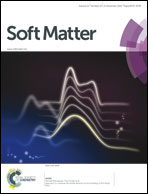Experimental study of the magnetic field enhanced Payne effect in magnetorheological elastomers
Abstract
The dynamic modulus and the loss factor of magnetorheological elastomers (MREs) of various compositions and anisotropies are studied by dynamic torsion oscillations performed in the absence and in the presence of an external magnetic field. The emphasis is on the Payne effect, i.e. the dependence of the elastomer magnetorheological characteristics on the strain amplitude and their evolution with cyclically increasing and decreasing strain amplitudes. MREs are based on two silicone matrices differing in storage modulus (soft, G′ ∼ 103 Pa, and hard, G′ ∼ 104 Pa, matrices). For each matrix, the concentration of carbonyl iron particles with diameters of 3–5 μm was equal to 70 and 82 mass% (22 and 35 vol%, respectively) in the composite material. Samples for each filler content, isotropic and aligned-particles, are investigated. It is found that the Payne effect significantly increases in the presence of an external magnetic field and varies with the cyclical loading which reaches saturation after several cycles. The results are interpreted as the processes of formation–destruction–reformation of the internal filler structure under the simultaneously applied mechanical force and magnetic field. Impacts of matrix elasticity and magnetic interactions on the filler alignment are elucidated.


 Please wait while we load your content...
Please wait while we load your content...